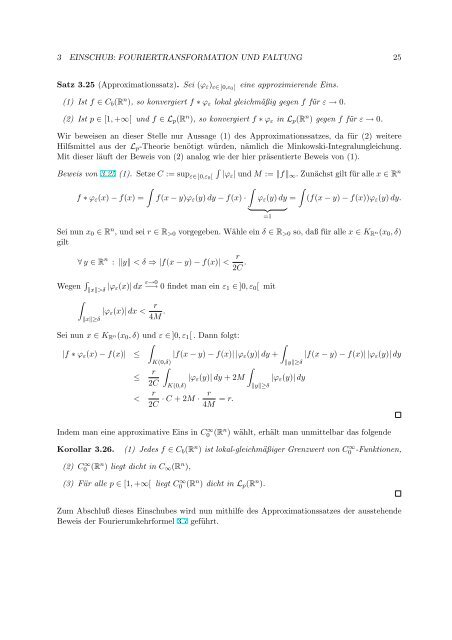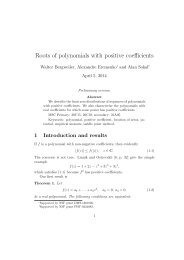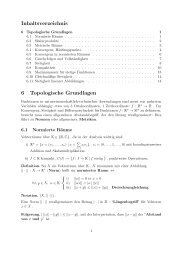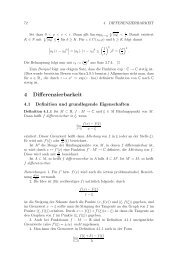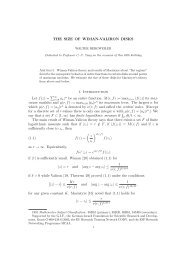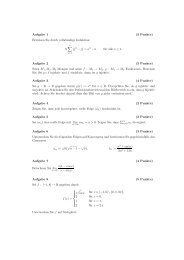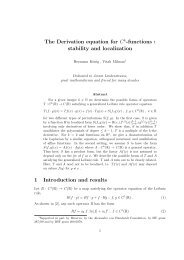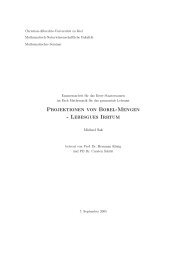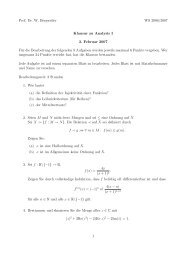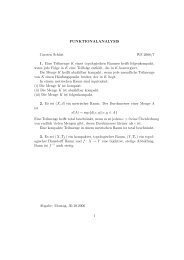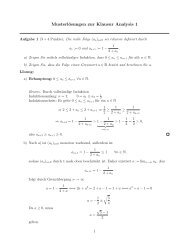Partielle Differentialgleichungen in der Finanzmathematik Vorlesung ...
Partielle Differentialgleichungen in der Finanzmathematik Vorlesung ...
Partielle Differentialgleichungen in der Finanzmathematik Vorlesung ...
Sie wollen auch ein ePaper? Erhöhen Sie die Reichweite Ihrer Titel.
YUMPU macht aus Druck-PDFs automatisch weboptimierte ePaper, die Google liebt.
3 EINSCHUB: FOURIERTRANSFORMATION UND FALTUNG 25Satz 3.25 (Approximationssatz). Sei (ϕ ε ) ε∈ ]0,ε0 [ e<strong>in</strong>e approximierende E<strong>in</strong>s.(1) Ist f ∈ C b (R n ), so konvergiert f ∗ ϕ ε lokal gleichmäßig gegen f für ε → 0.(2) Ist p ∈ [1, +∞[ und f ∈ L p (R n ), so konvergiert f ∗ ϕ ε <strong>in</strong> L p (R n ) gegen f für ε → 0.Wir beweisen an dieser Stelle nur Aussage (1) des Approximationssatzes, da für (2) weitereHilfsmittel aus <strong>der</strong> L p -Theorie benötigt würden, nämlich die M<strong>in</strong>kowski-Integralungleichung.Mit dieser läuft <strong>der</strong> Beweis von (2) analog wie <strong>der</strong> hier präsentierte Beweis von (1).∫Beweis von 3.25 (1). Setze C := sup ε∈ ]0,ε0 [ |ϕε | und M := ‖f‖ ∞ . Zunächst gilt für alle x ∈ R n∫f ∗ ϕ ε (x) − f(x) =∫∫f(x − y)ϕ ε (y) dy − f(x) · ϕ ε (y) dy = (f(x − y) − f(x))ϕ ε (y) dy.} {{ }=1Sei nun x 0 ∈ R n , und sei r ∈ R >0 vorgegeben. Wähle e<strong>in</strong> δ ∈ R >0 so, daß für alle x ∈ K R n(x 0 , δ)gilt∀ y ∈ R n : ‖y‖ < δ ⇒ |f(x − y) − f(x)| δ |ϕ ε(x)| dx ε→0 −→ 0 f<strong>in</strong>det man e<strong>in</strong> ε 1 ∈ ]0, ε 0 [ mit∫‖x‖≥δ|ϕ ε (x)| dx < r4M .Sei nun x ∈ K R n(x 0 , δ) und ε ∈ ]0, ε 1 [ . Dann folgt:∫∫|f ∗ ϕ ε (x) − f(x)| ≤ |f(x − y) − f(x)| |ϕ ε (y)| dy +≤K(0,δ)r2C∫K(0,δ)< r2C · C + 2M ·∫|ϕ ε (y)| dy + 2Mr4M = r.‖y‖≥δ‖y‖≥δ|ϕ ε (y)| dy|f(x − y) − f(x)| |ϕ ε (y)| dyIndem man e<strong>in</strong>e approximative E<strong>in</strong>s <strong>in</strong> C ∞ 0 (Rn ) wählt, erhält man unmittelbar das folgendeKorollar 3.26.(1) Jedes f ∈ C b (R n ) ist lokal-gleichmäßiger Grenzwert von C ∞ 0 -Funktionen,(2) C ∞ 0 (Rn ) liegt dicht <strong>in</strong> C ∞ (R n ),(3) Für alle p ∈ [1, +∞[ liegt C ∞ 0 (Rn ) dicht <strong>in</strong> L p (R n ).Zum Abschluß dieses E<strong>in</strong>schubes wird nun mithilfe des Approximationssatzes <strong>der</strong> ausstehendeBeweis <strong>der</strong> Fourierumkehrformel 3.7 geführt.


